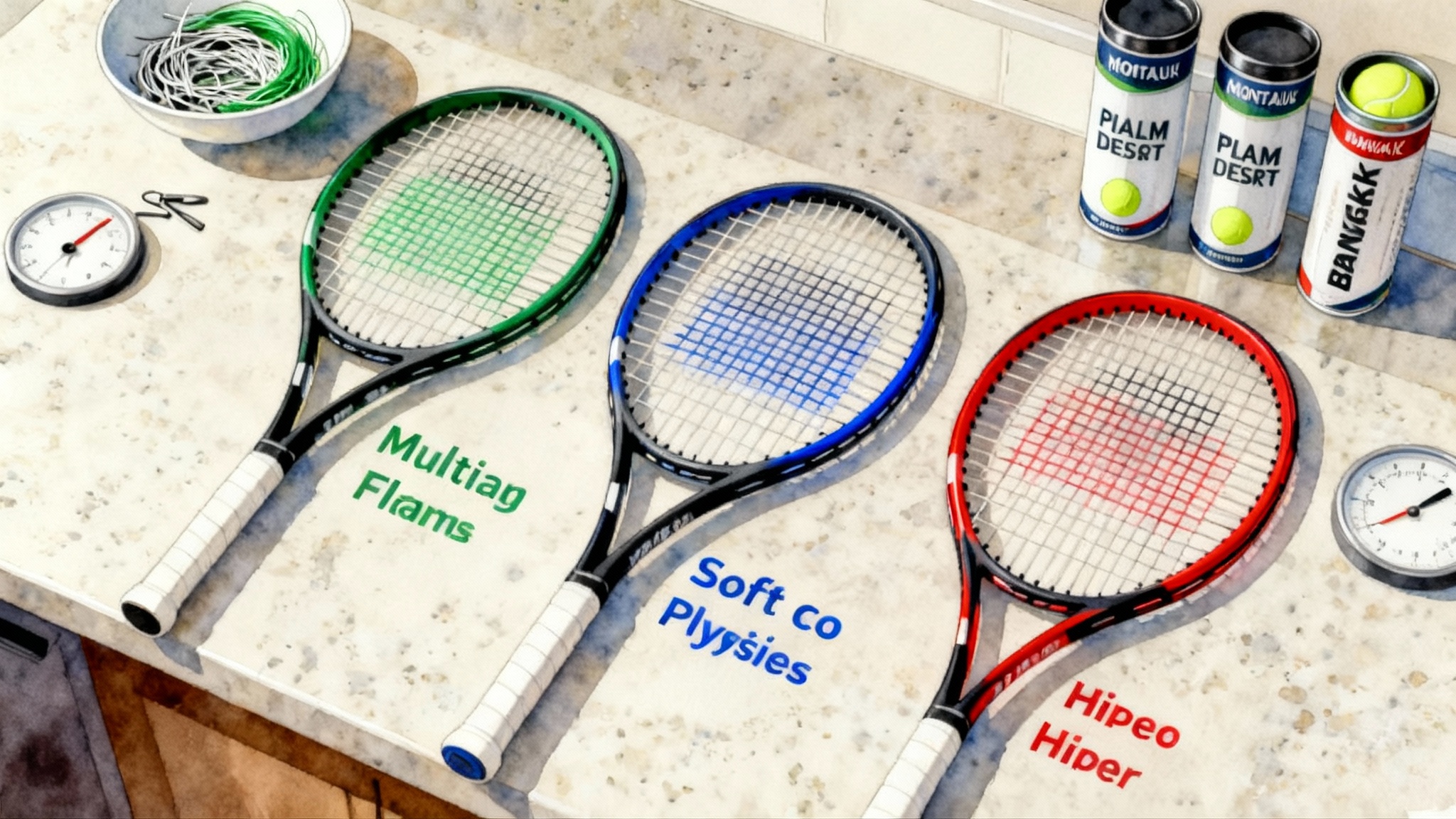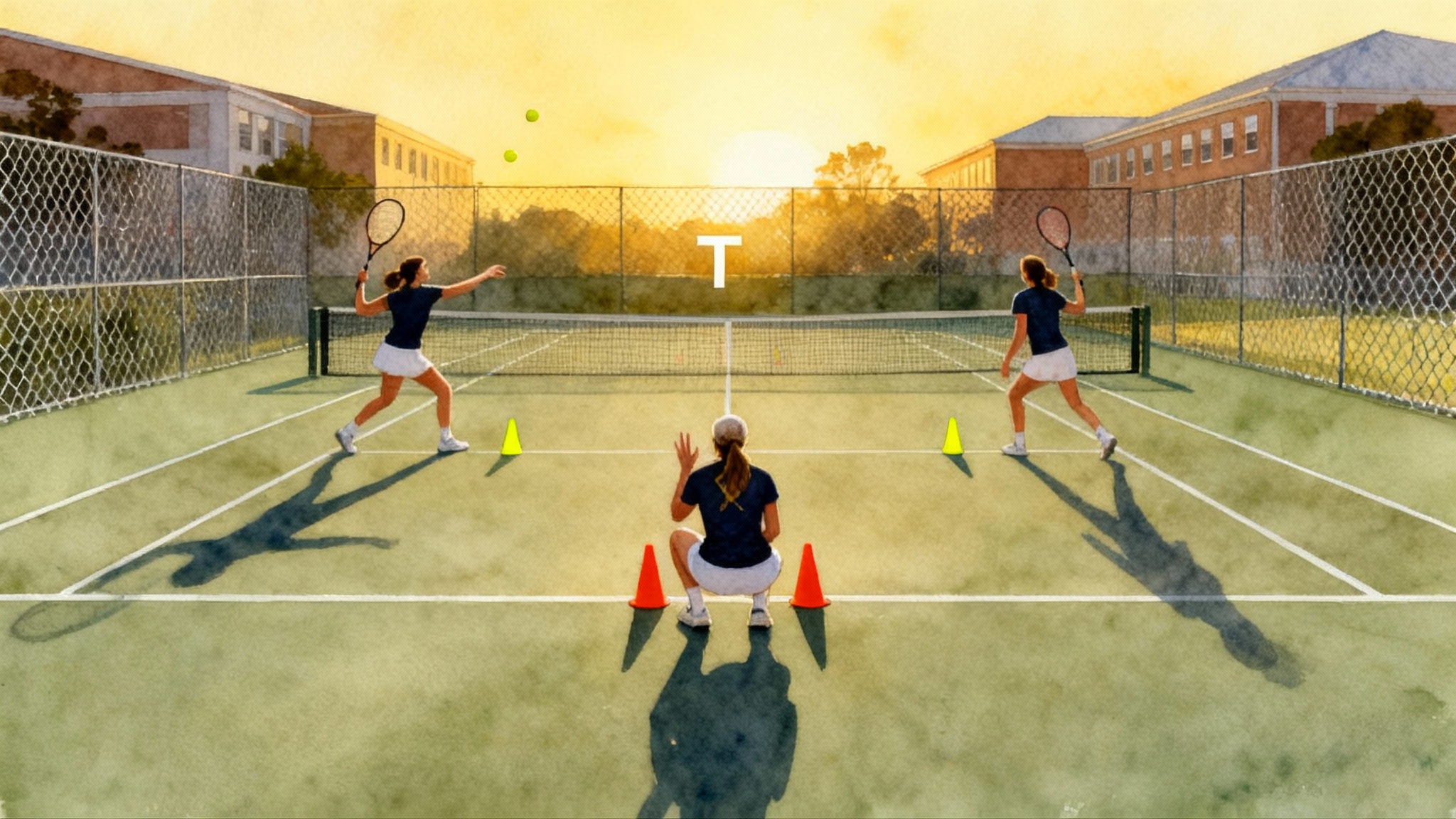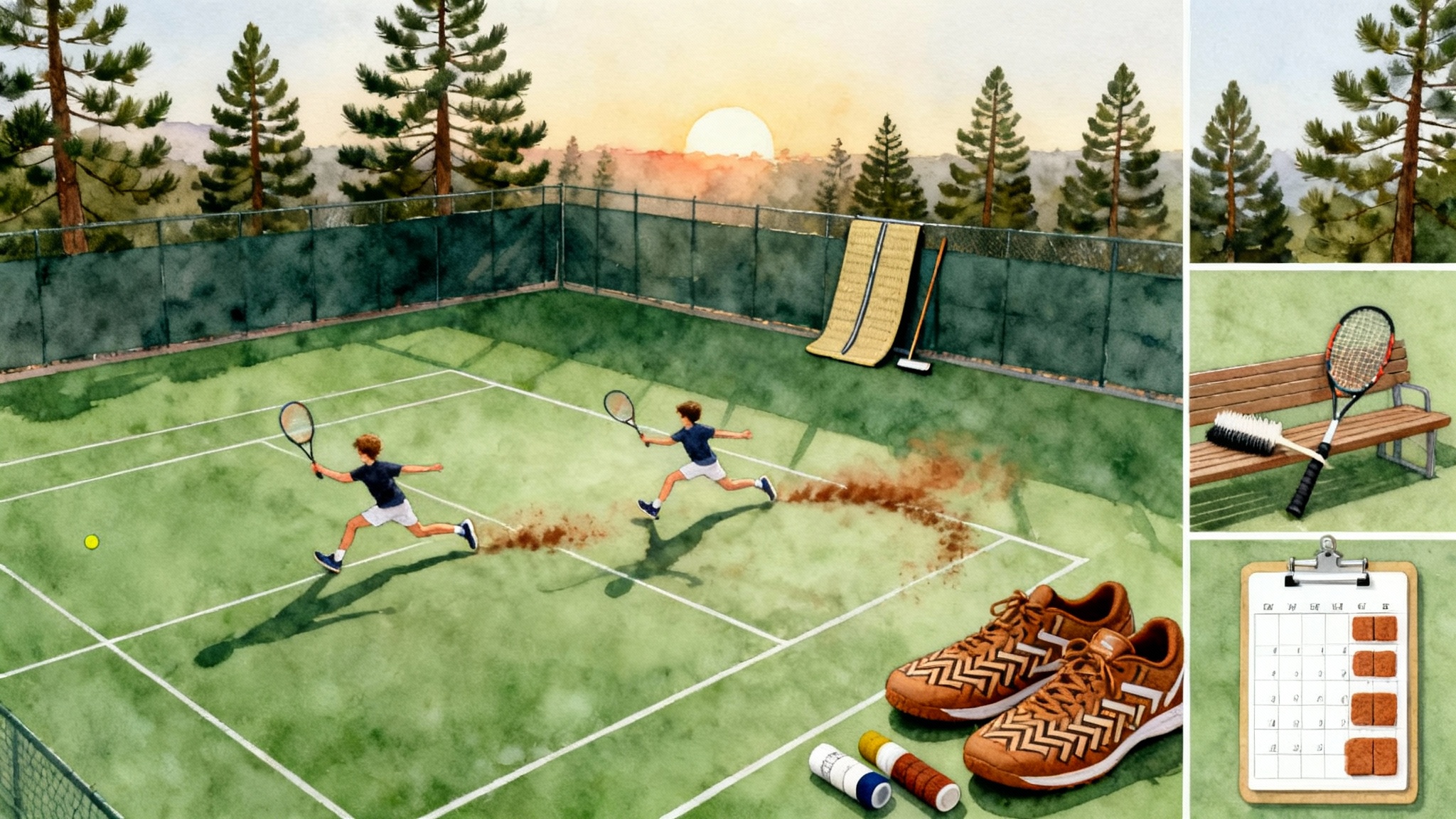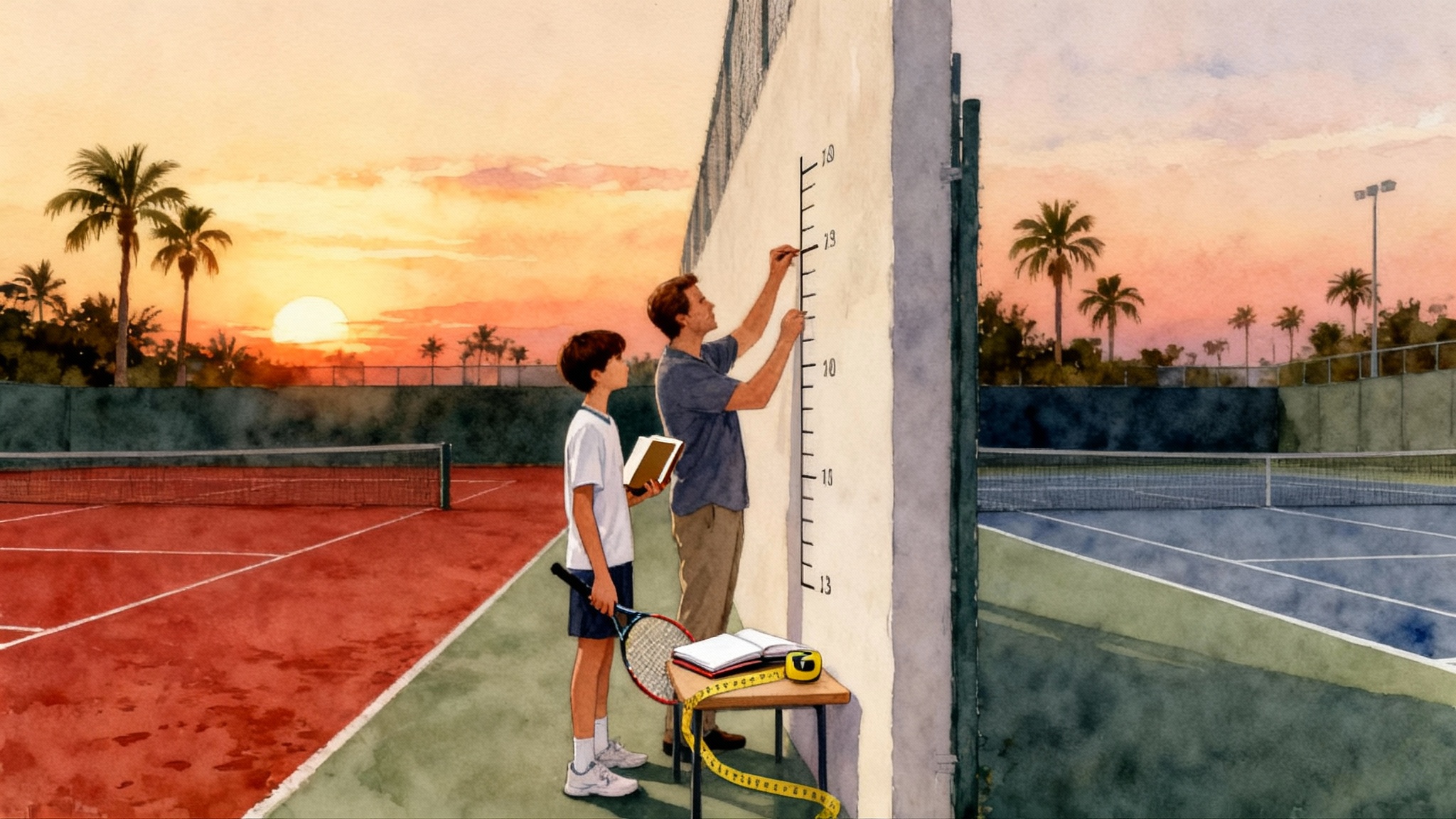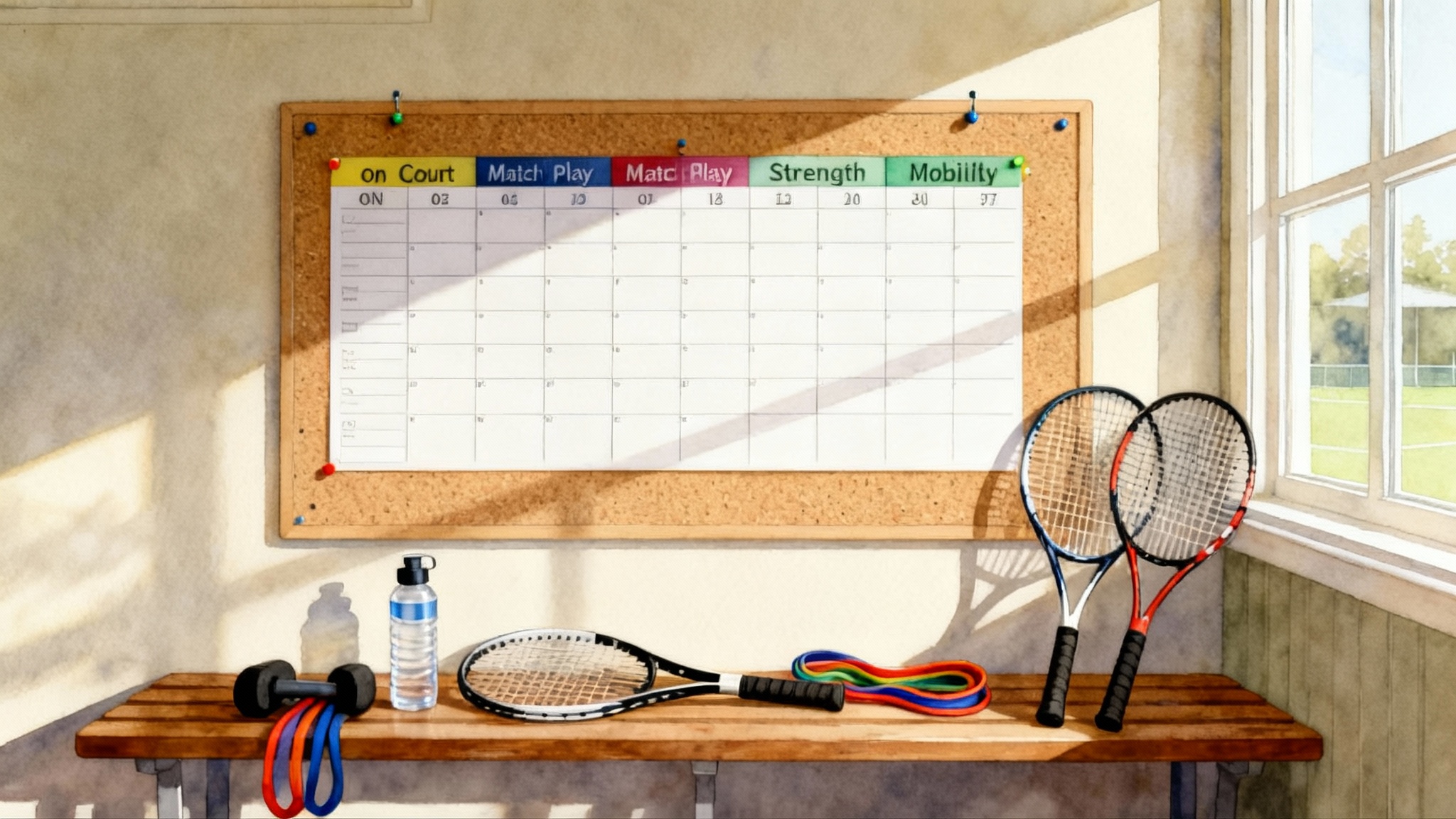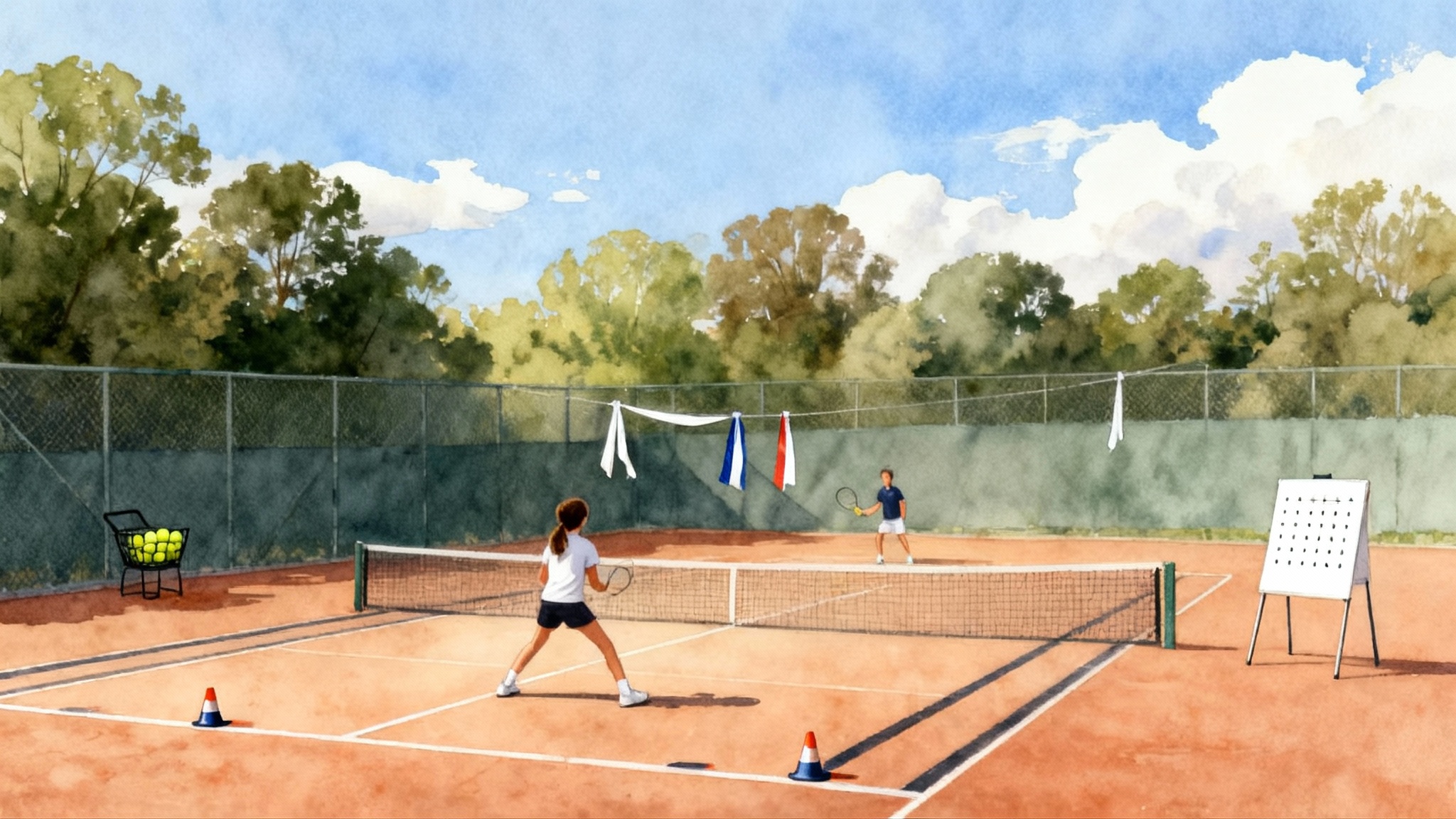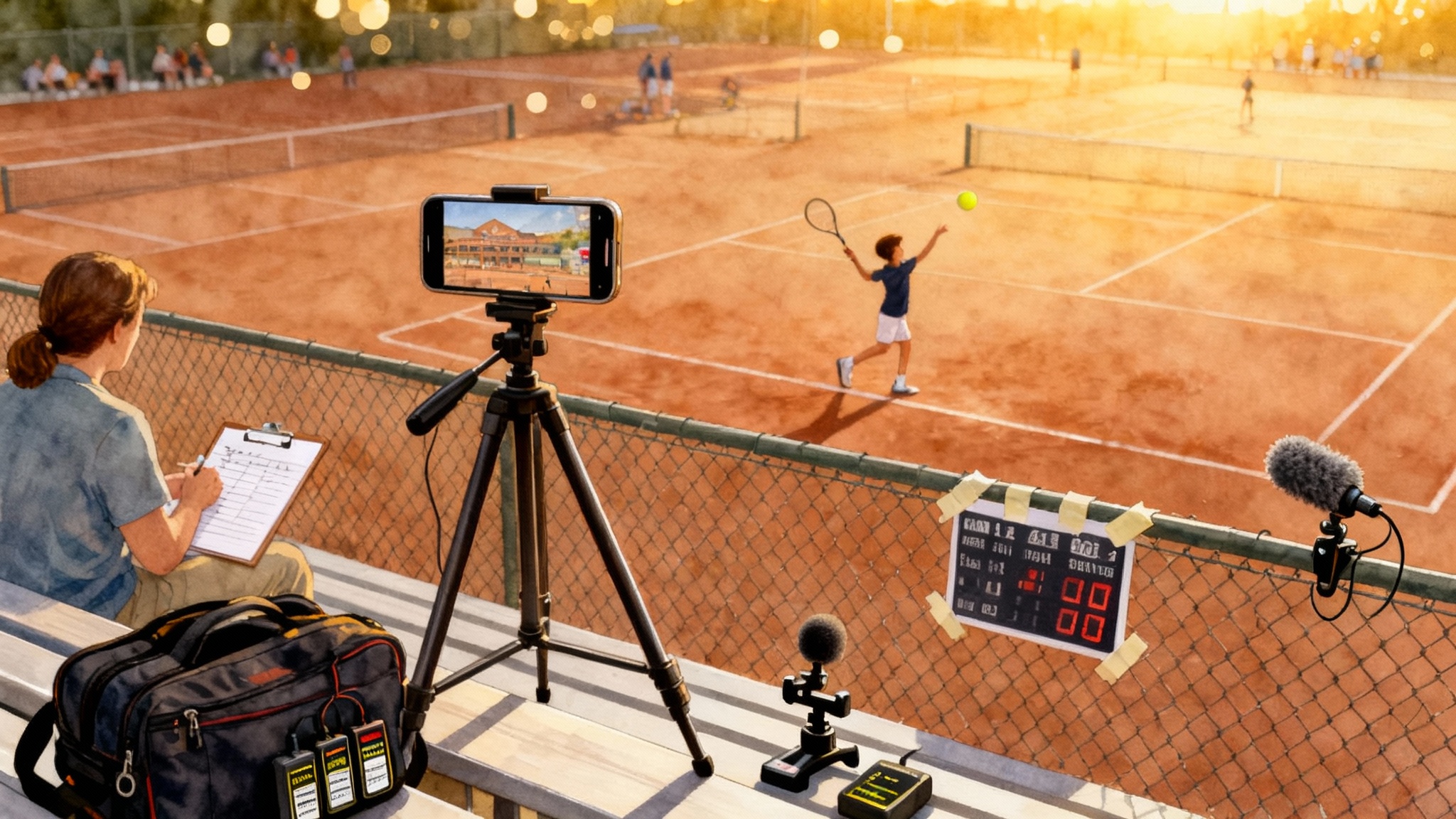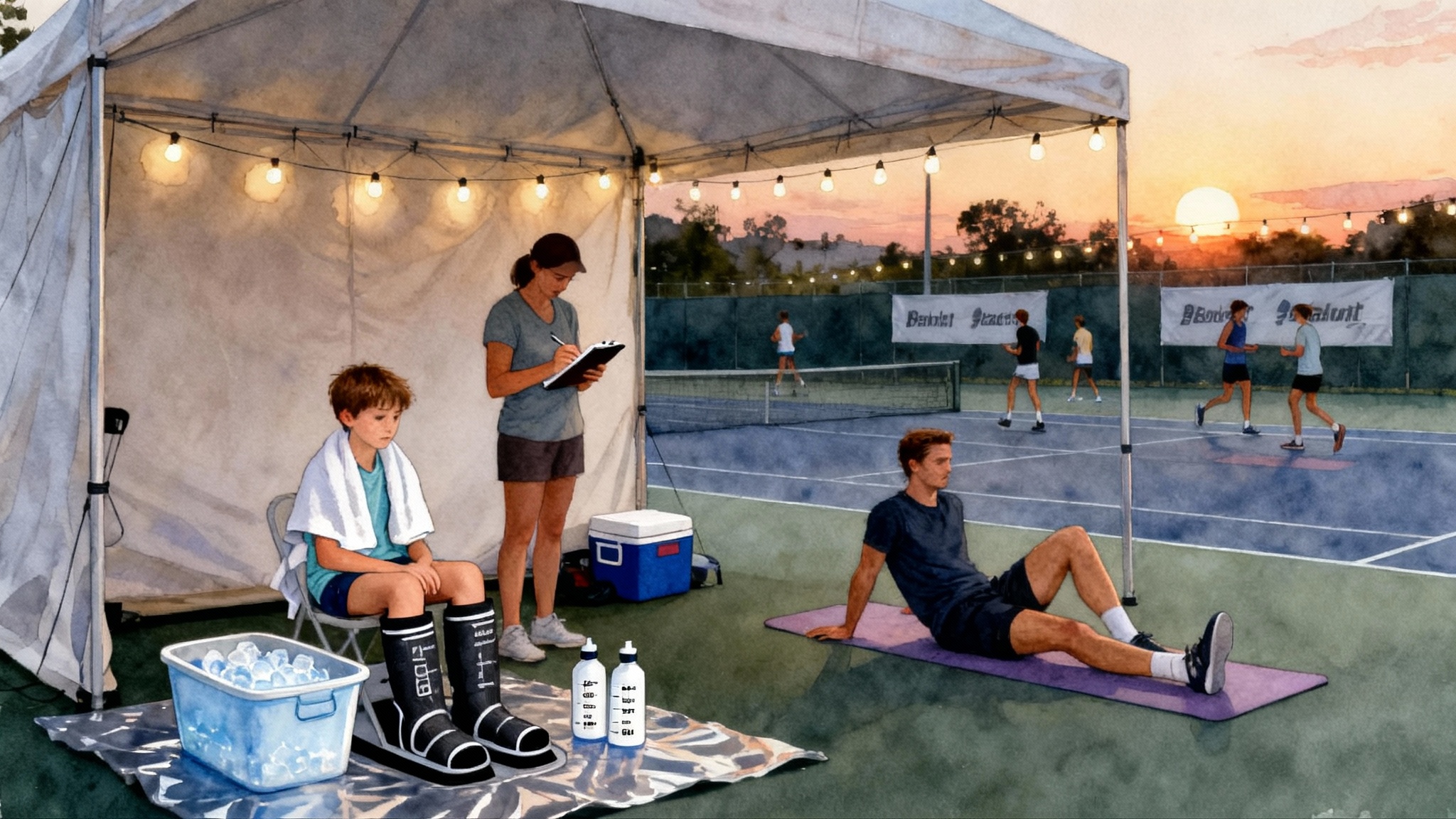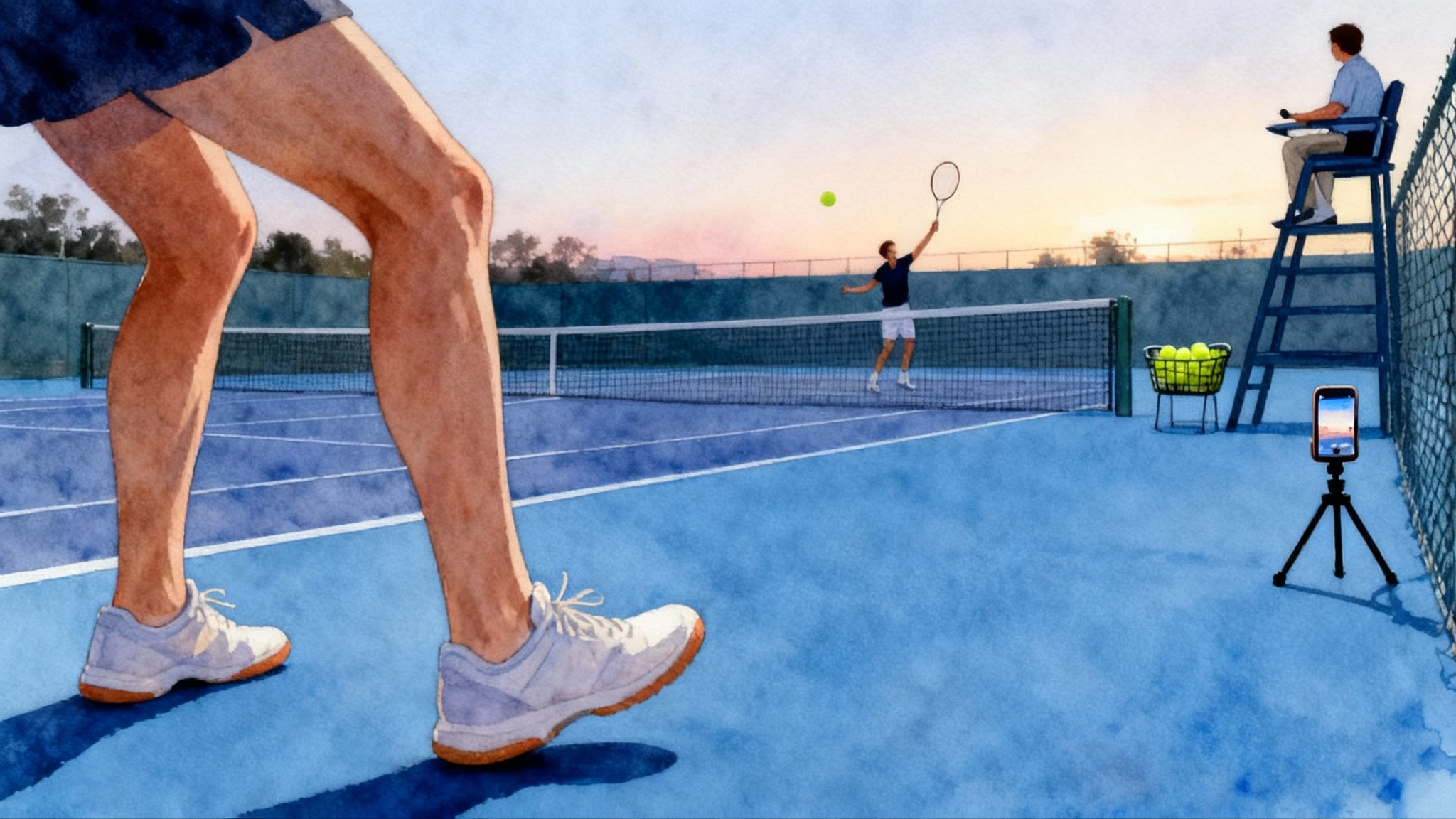Indoor Tennis Transition: 4-Week Guide for Players and Parents
Move from outdoor to indoor with a clear 4-week plan. Learn spacing and footwork tweaks, serve and return timing, vision and reaction drills, and smart conditioning. Includes parent checklists and ready-to-run session templates.
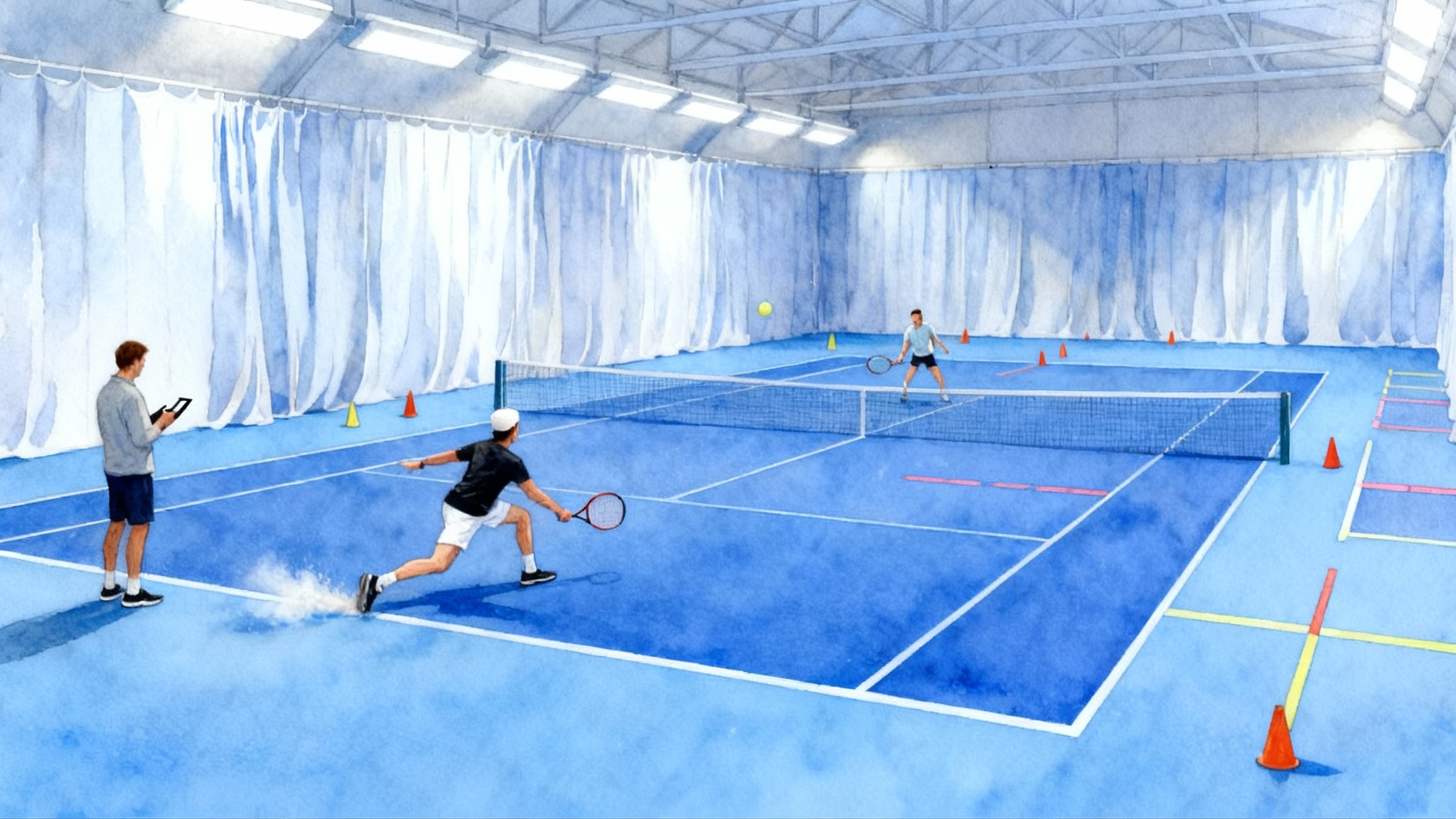
Why indoor tennis feels different this winter
When you walk into an indoor facility, tennis changes in three important ways. The pace feels faster because there is no wind or sun to slow or misdirect the ball. The bounce is often lower and skids through the court since indoor hard or carpet courts are smoother and drier than most outdoor surfaces. The environment is tighter, with lights above you, curtains on the sides, and sound reflecting off the ceiling that makes the game feel closer and louder. Understanding these three differences is the starting point for a smooth transition.
Think of outdoor rallies as running on a hiking trail and indoor rallies as sprinting on a track. The distance is similar, but the speed, traction, and rhythm are not. Your four-week plan below uses that idea to change how you move, time your serve and return, train your eyes, and condition your body for the sharper pace.
The four-week playbook at a glance
- Week 1: Rebuild spacing and footwork for a lower, quicker bounce.
- Week 2: Retune serve and return timing for a still, bright indoor environment.
- Week 3: Upgrade vision, reaction, and contact consistency.
- Week 4: Convert skills into match play with indoor-specific patterns and conditioning.
Each week includes on-court drills, off-court work, and simple metrics to track progress. Juniors, parents, and adult players can follow the same structure with load adjusted by age and training history.
If you want a coach-guided start, book a thirty-minute indoor evaluation on TennisAcademy by selecting a skill assessment and court-movement screen. You will leave with a personal court map for spacing and a two-page drill sheet.
Week 1: Spacing and footwork for the lower bounce
Goal: Move earlier and lower so contact happens in front of the body, not beside or behind it.
What changes indoors:
- The ball reaches you sooner because there is no wind and less air resistance.
- Skidding bounces reduce your contact height, especially on flatter shots and slices.
- Tight side curtains and faster nets punish lazy recovery steps.
Core adjustments:
- Soften the first step: Replace a big crossover with two short adjustment steps. This keeps the chest facing the net longer, which stabilizes the swing path.
- Lower the base: Bend at the hips and ankles first, then the knees. Think of your belt buckle aiming slightly down before contact.
- Contact in front: Aim to strike the ball a palm’s length in front of your lead hip. Tape a line on the court during practice as a visual target.
Drills:
- Short-hop lanes (10 minutes)
- Set cones 3 feet inside each singles sideline. Feed firm, skidding balls that land near the service line.
- Goal: Two micro-shuffles into contact, then a balanced recover step to center.
- Metric: 20-ball set with 15 balanced contacts or better.
- Three-box depth ladder (12 minutes)
- Mark three depth zones: just beyond the service line, mid-baseline, and deep baseline.
- Rally cooperatively. The hitter must take the ball on the rise in zone one, at waist height in zone two, and shoulder height in zone three.
- Rotate zones every 90 seconds.
- Metric: At least 8 clean contacts per minute without framing.
- Split-step timing reset (8 minutes)
- Count the opponent’s contact out loud. Land your split step as their strings meet the ball.
- Film 30 seconds. Your feet should be fully grounded at opponent contact, not still in the air. For a quick tune-up, learn how to fix your split-step timing.
Off-court conditioning, Week 1 (20 minutes, twice per week)
- Ankles and Achilles: 3 sets of 8 slow calf raises off a step, 3-second lower.
- Lateral stiffness: 3 sets of 6 single-leg lateral hops to a stable stop.
- Core bracing: 3 sets of 20-second dead bug holds.
- Recovery: Walk 10 minutes post-session. Indoor courts are less forgiving, so joint care matters.
Parent role this week
- Film from the side for 60 seconds during spacing drills. Freeze the frame at contact. Check if contact is in front of the hip and if knees are flexed.
- Pack two dry overgrips and a towel. Indoor air is dry, and grips glaze faster.
Week 2: Serve and return timing in a still, bright environment
Goal: Adjust toss height, rhythm, and return spacing for a ceiling and lighting system that does not move.
What changes indoors:
- No sun or wind means tosses need less margin. A high toss floats and forces you to wait, which leaks power.
- Lighting and ceiling height create a visual boundary, so you must define your launch window and return position precisely.
- Sound arrives instantly, which helps you time the return if you listen for string-on-ball.
Serve adjustments:
- Slightly lower toss: Reduce toss height so the ball peaks just above your fully extended reach. This tightens the rhythm and increases hit rate.
- Quicker load: Start your knee bend earlier, right after the ball leaves your hand.
- Targets and spin: Aim for a can-sized target at the T and wide corners. Use a heavy slice out wide to open the court, then a flatter body serve to jam.
Return adjustments:
- Stance line: Place a strip of tape 18 to 24 inches behind the baseline. Start there on first serves and step in on second serves.
- Shorter backswing: Think “block then guide” rather than “loop and rip” on first-serve returns.
- Audible timing: Say “hit” when you hear the server strike the ball, then “bounce” when it lands. This locks your split-step landing to their contact. For deeper work, use our guide to master the return of serve.
Drills:
- Two-toss ladder (8 minutes)
- Hit five serves with your usual toss, then five with a toss that peaks one ball height lower.
- Track first-serve percentage and perceived effort. Keep the toss that gives you 5 percent better accuracy with equal or lower effort.
- Three-block return series (12 minutes)
- Partner serves first serves only. You must use a compact takeback and a firm block.
- Score one point for a deep cross return, two points for a deep middle return that jams. Race to 15.
- Serve plus one patterning (10 minutes)
- Serve wide, recover with a small hop to center, then attack the open court with a heavy cross shot.
- Metric: 8 out of 10 points finished in two or fewer shots.
Off-court, Week 2
- Shoulder care: 2 sets of 15 external rotations with a light band, 2 sets of 10 prone Y raises.
- Hip drive: 3 sets of 6 split-squat jumps with soft landings.
- Diaphragm reset: 3 slow breaths, 6-second inhale through the nose, 6-second exhale through pursed lips, between serving blocks to keep the head clear.
Parent role this week
- Toss window check: From behind the server, track if the ball peaks above or outside the hitting shoulder. Film 10 serves and count how many peak in your intended window.
- Return safety: Watch for the junior drifting inside the baseline on first serves. Mark the stance line with tape.
Ready to turn these adjustments into a plan with a coach and facility courts? Find a nearby partner academy and reserve your slot for small groups and match play through our guided booking flow.
Week 3: Vision and reaction that fit indoor speed
Goal: Train your eyes and head movement so you pick up the ball early, track the bounce, and keep your head still through contact.
What changes indoors:
- The ball picture is cleaner inside, so you can commit earlier if you train your visual habits.
- Bright lights from above make it tempting to look up on contact, especially on higher backhands and overheads.
Vision and reaction drills:
- Contact box focus (8 minutes)
- Place a small square of tape on the court where you want contact. During fed balls, call out the letter C when you see the ball cross that square.
- The goal is to keep the head still through contact while your eyes finish the letter.
- Color call rally (10 minutes)
- Mark one ball with a small colored dot using a marker. Mix it into a basket of regular balls.
- Feed or rally and call “dot” the moment you pick it up out of the opponent’s strings.
- This trains early ball recognition and reduces flinching on fast balls.
- Bounce to strike cadence (10 minutes)
- Say “bounce” at the bounce and “hit” at your contact. Keep the time between words even.
- Increase rally pace slightly and maintain the same cadence.
- Overhead lanes with ceiling awareness (8 minutes)
- Draw two landing lanes in the deuce and ad service boxes.
- Partner lobs at medium height. Keep your eyes on the ball without craning your neck.
- Metric: 8 out of 10 overheads landing inside the lanes without grazing lights or ceiling awareness panels.
Off-court, Week 3
- Saccade and track: Hold two numbers on sticky notes at eye level, three feet apart. Snap your eyes from left to right for 20 seconds, rest, then track a ball in a figure eight for 20 seconds. Repeat three rounds.
- Neck and upper back: 2 sets of 6 slow chin tucks and 6 thoracic rotations. A calm head supports a calm swing.
Parent role this week
- Stand near the net post and watch the player’s head through contact. A still head looks like a tripod. Praise it when you see it.
- On lobs, remind the player to move with small steps instead of backpedaling straight back.
Week 4: Pattern play, point building, and indoor conditioning
Goal: Build repeatable patterns that fit indoor pace and court coverage, then layer in conditioning that matches short, intense points.
Indoor-friendly patterns:
- Serve wide, attack open court, finish to the body.
- Deep middle neutral ball, then angle to move the opponent off the doubles alley.
- Short skid slice to the backhand, follow with a high-rolling forehand to the opposite corner.
Pattern drills:
- Two-ball capture (12 minutes)
- Start neutral. You must win the point in two balls after your serve or return.
- This forces a clear plan and quick feet.
- Body-then-angle live points (12 minutes)
- First ball must be deep middle, second ball must find a corner.
- Score one point for finishing in under five strokes, two points for finishing in three.
- Short-court transition race (10 minutes)
- Start one player on the service line and the other at the baseline. The transition player must create a volley in two balls.
- Switch every four points.
Indoor conditioning, Week 4
- Court sprints: 6 repeats of baseline to net and back, 20 seconds rest between.
- Lateral shuttles: 3 sets of 2 x 10-second side shuffles touching singles sideline to center, 30 seconds rest.
- Med ball or shadow swings: 3 sets of 6 explosive forehand and backhand reps focusing on a stable base.
- Cooldown: 5 minutes of easy rally and 5 minutes of walking. Hydrate. Indoor air is dry.
Parent role this week
- Track patterns. Note which first-strike patterns score above 60 percent in live points. Encourage the player to open their match with those patterns.
- Check recovery: pack a water bottle and a light snack, and schedule a 10-minute walk after the session before the car ride home.
Session templates you can use tonight
Sixty-minute adult session
- Warm up, 8 minutes: Mini tennis, bounce to strike cadence.
- Movement reset, 10 minutes: Short-hop lanes with two micro-shuffles.
- Serve and return, 15 minutes: Two-toss ladder and three-block return series.
- Pattern play, 20 minutes: Two-ball capture then body-then-angle.
- Cooldown, 7 minutes: Walk the court, shoulder care band series.
Ninety-minute junior group session
- Warm up, 10 minutes: Color call rally, split-step timing reset.
- Spacing block, 15 minutes: Three-box depth ladder.
- Serve plus one, 20 minutes: Targets at T and wide, recover hop, plus one to open court.
- Vision and overheads, 15 minutes: Contact box focus, overhead lanes.
- Live games, 20 minutes: Short-court transition race and two-ball capture.
- Cooldown, 10 minutes: Saccade and track drill, ankle and Achilles work.
Parent sideline checklist
- Film from the side and behind for 30 to 60 seconds each.
- Confirm two dry overgrips, a small towel, and a water bottle in the bag.
- Pack non-marking shoes and a spare pair of socks.
- Ask your player to name their go-to first-strike pattern before live play starts.
Gear and facility checklist
- Shoes: non-marking soles with fresh tread, especially for carpet or smooth hard courts.
- Grips: two to three extra overgrips to handle dry air.
- Balls: bring a fresh can for serve work and a practice mix for drills.
- Layers: indoor temperature varies. Wear a light layer you can shed after five minutes.
- Safety: no backpedaling on lobs. Use small steps to turn and chase.
Integrating with an indoor academy and booking smarter
If you train with an academy such as CourtSense or a similar high-touch indoor program, use the four-week plan as your backbone, then plug into three offerings that accelerate results.
- Assessment block: Start with a 30 to 45 minute movement and stroke screen under indoor lighting. Ask for measurement on split-step timing, contact depth, and serve toss height.
- Small-group classes: Choose a class that caps at four players per court so you can keep the tempo high and the coaching specific. Share your Week 1 and Week 2 priorities at check-in.
- Match-play blocks: Reserve a weekly 90-minute slot with set play and score reporting. Focus on the patterns you built in Week 4.
On TennisAcademy you can book these pieces in one flow. Select a local partner, add a skill assessment and court-movement screen, pick a small-group class that matches your level, then attach a weekend match-play block. You will receive a single schedule and a digital card that lists your metrics for the month.
Two schedules to follow
Three-day plan per week
- Day 1: Spacing and footwork block, then cooperative rallies with depth targets.
- Day 2: Serve and return focus, then serve plus one patterns.
- Day 3: Vision and reaction, then live points with a two-ball finish constraint.
Two-day plan per week
- Day 1: Combine spacing work with serve plus one.
- Day 2: Vision and return, then pattern play games.
If you can only train once per week, rotate the focus each week: Week 1 spacing, Week 2 serve and return, Week 3 vision, Week 4 patterns and conditioning.
Metrics that prove you are adapting
- Contact in front: 80 percent of forehands struck a palm’s length in front of the lead hip on film.
- First-serve percentage: 60 percent or better with the tighter toss window.
- Return depth: 7 out of 10 first-serve returns land past the service line.
- Pattern success: Your chosen two-ball pattern wins 6 out of 10 live points.
- Movement efficiency: In 30 seconds of film, no more than one unnecessary crossover on neutral balls.
Frequently asked questions
What if my indoor club has low ceilings?
- Use a slightly lower toss and prioritize body and T serves. On overheads, let marginal lobs bounce. The second hit is often easier and safer than clipping a ceiling tile.
Do I need a different racquet or string for indoors?
- Not necessarily. Start by lowering string tension by one to two pounds to add pocketing. Reassess after two weeks of consistent training. For more detail, see our guide to safe string and tension setups.
How do I help a junior who is anxious indoors?
- Shorten drills and add clear targets. Use the color call rally and bounce to strike cadence to keep attention on the ball, not the building.
A smart conclusion for a faster court
Indoor tennis rewards preparation. The ball gets to you faster, the bounce sits lower, and the environment compresses your time to react. Rather than changing your entire game, change your timing and spacing by a small margin that you can measure. Land the split step when you hear opponent contact, shorten the toss to match your reach, and build two first-strike patterns that hold up at speed. With four focused weeks and a few minutes of film, you can turn winter into the most productive block of your year.
If you want coaching support, reserve an assessment and small-group spot through TennisAcademy, then add a match-play block to test your patterns. The plan is clear, the court is waiting, and your best indoor tennis is four weeks away.
